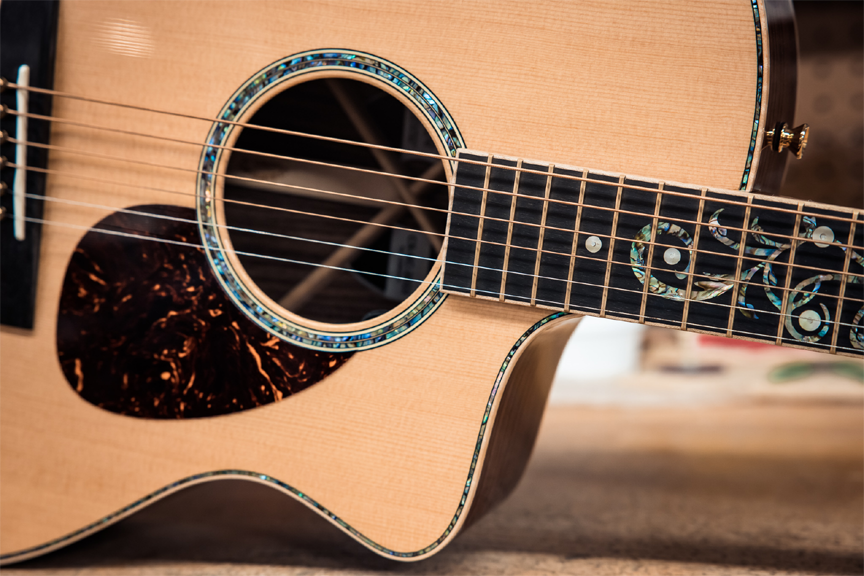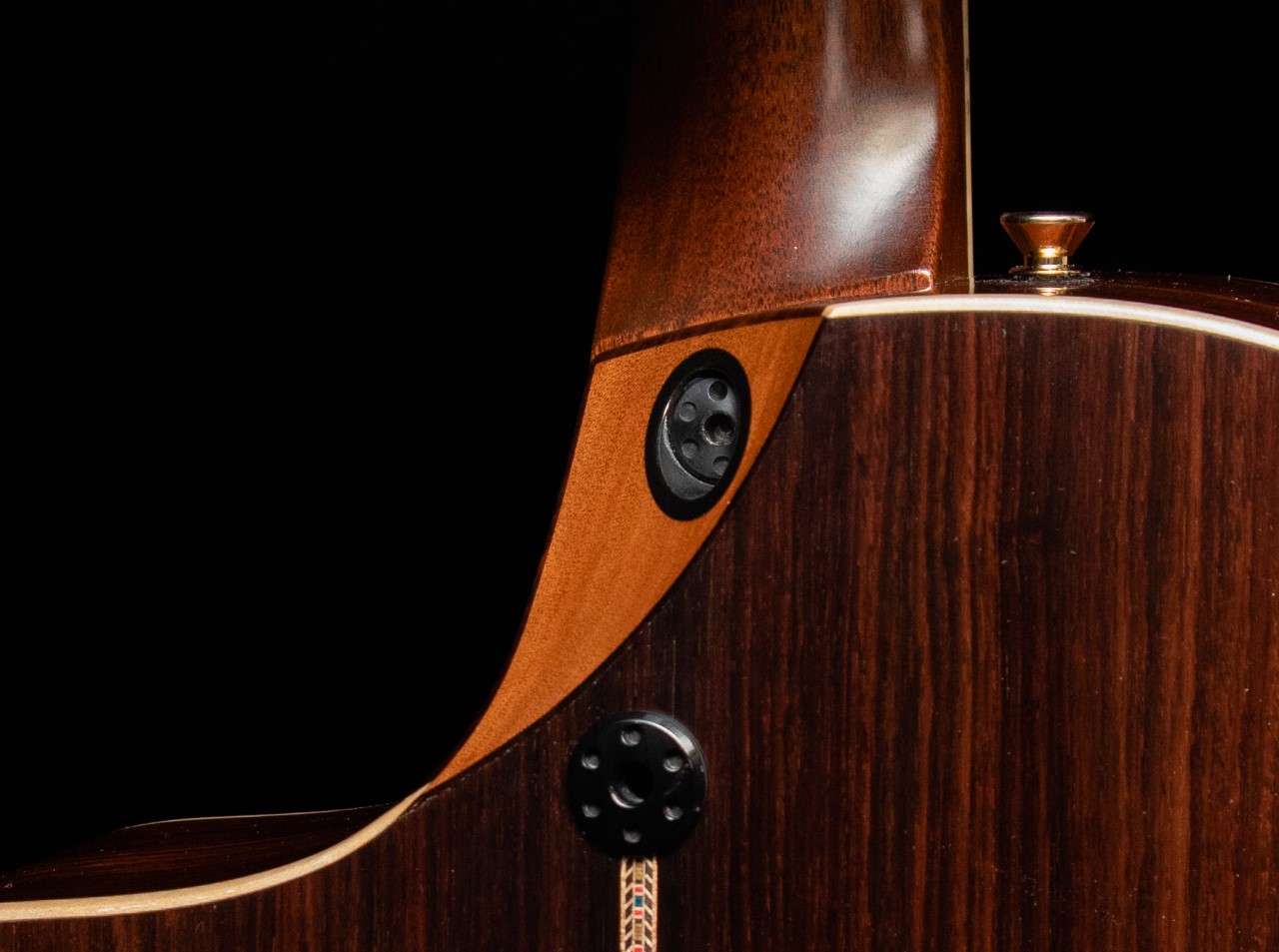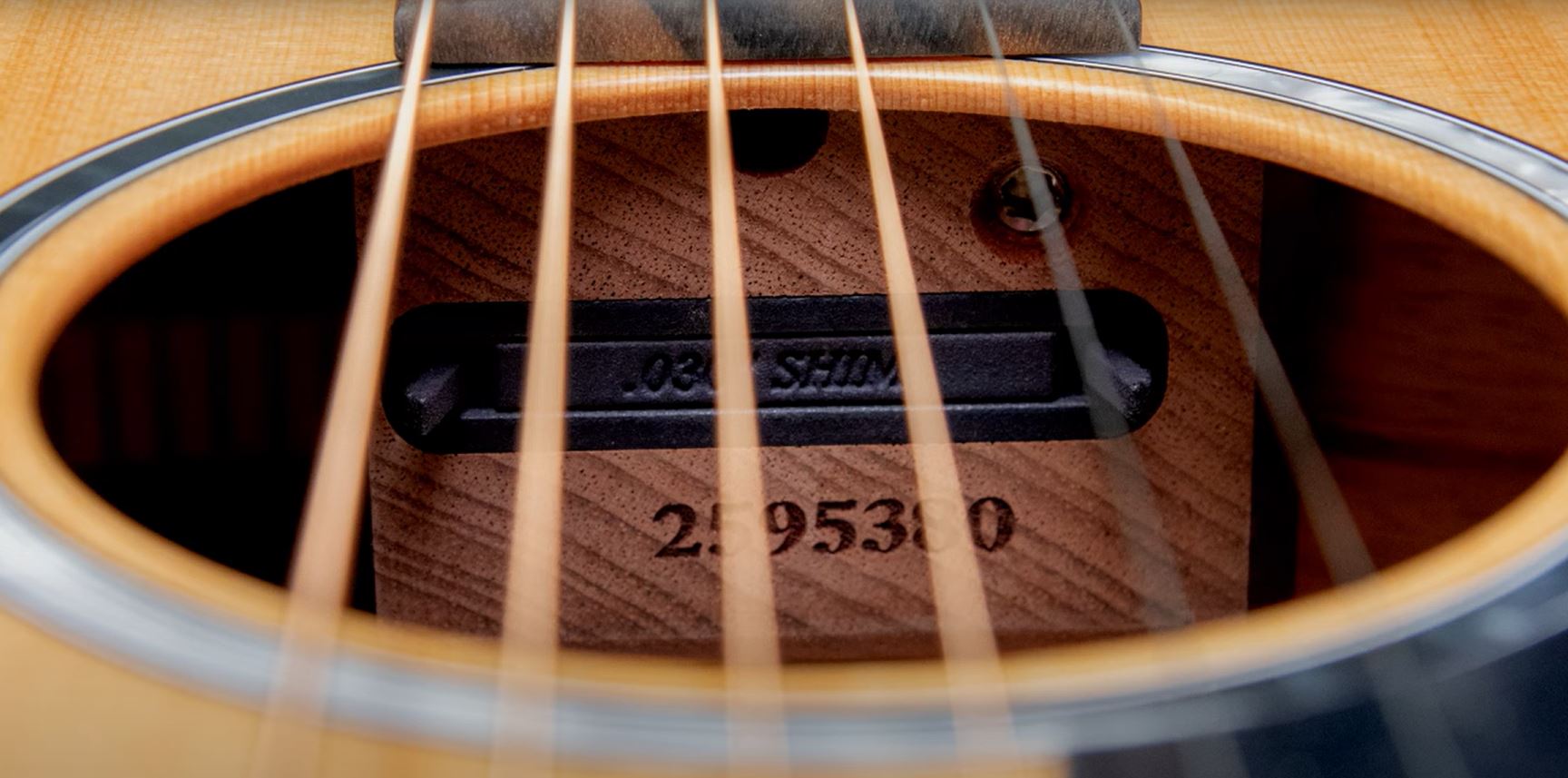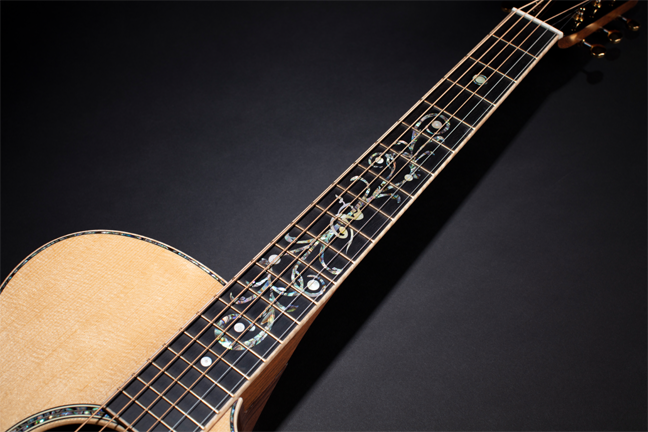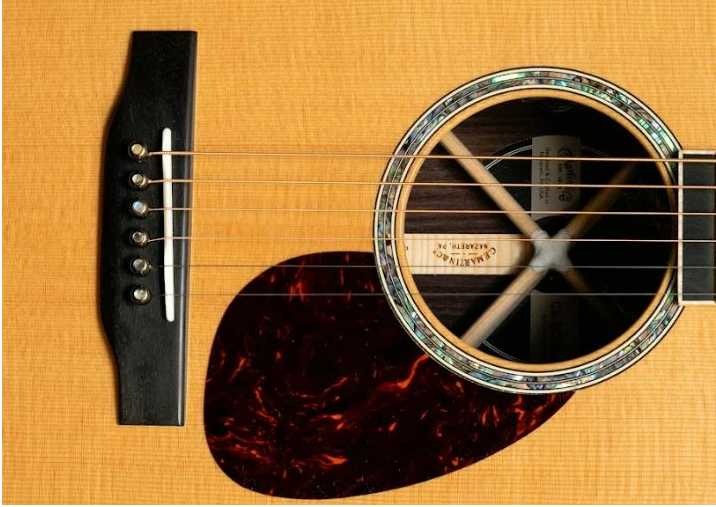The first Martin 13-fret guitar made in the Custom Shop, the CS-SC-22 shines
New tone-improving technology exceeds expectations
CS-SC-13 specs include: 13-fret asymmetrical S body size with deep scoop cutaway; solid East Indian rosewood back and sides; solid VTS Sitka spruce top, with newly patented internal soundboard recurve; VTS Adirondack spruce Tone Tension X-bracing with proprietary shaping; heel-less solid Genuine Mahogany neck with Sure Align neck joint system and ergonomic Low Profile Velocity shaping; solid ebony fingerboard with High Performance Taper and EVO Gold frets; solid ebony belly bridge with 1930 profile but smooth contour surface; 2-5/32” string spacing; abalone shell appointments exclusive to this model; faux tortoise asymmetrical teardrop pickguard; gold-colored Waverly high-ratio open back tuners; Fishman Aura VT Blend electronics with Aura HD imaging and onboard anti-feedback technology. Comes with a silver molded hard-shell case with plush lining.
“Unplugged, the CS-SC-22 resonates with a warm harmonic complexity beyond the capability of other SC models. But its maximum potential will be realized during amplified on-stage performances.”
(Watch with full HD settings for best sound.)
S for Super Martin
The CS-SC-22 is crafted in Martin’s Custom Shop with the 13-fret S body size that has an extended Cutaway. It is available for dealer orders only in 2022.
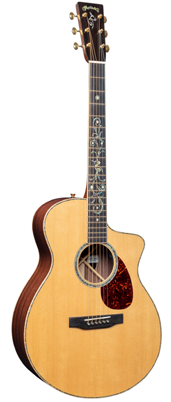
Unlike historical Martin body size names, the S is not an initial. It was chosen because Tim Teel, Martin’s Head of Instrument Design, kept drawing sweeping S shapes during the initial brainstorming that led to this extraordinary 13-fret body.
Despite the symmetrical model name, this CS SC is an asymmetrical guitar with an asymmetrical body, asymmetrical bracing, and asymmetrical neck. It even has an asymmetrical pick guard.
The waist of the CS-SC-22 is tilted, shifting cubic space forward on the bass side of the body, so the upper bout meets the neck at the 13th fret. A similar amount of space is shifted downward on the treble side, allowing for the deep cutaway without removing too much of the sound chamber. It gives the entire body a subtly abnormal, somewhat warped appearance. The asymmetrical skew also makes it very comfortable to play sitting down because of the location of that treble-side waist curve.
The jewel of Martin’s 2022 NAMM show, this is the first deluxe SC model and the first SC made in the USA. It is adorned with high-color abalone shell inlaid around the edge of the Sitka spruce top, ala Style 41, and a double helping of abalone around the sound hole. An elaborate abalone vine winds its graceful way up the EVO Gold frets and around the pure mother-of-pearl fret position markers on the flawless ebony fingerboard. The golden frets aren’t just pretty; the EVO copper alloy resists wear and tear that would cut trenches into normal fret wire.
The headstock face plate is made from jet-black ebony, inlayed with a stylized sprig from the vine and crowned with a glittering abalone C. F. Martin & Co. logo, in the same flowing script as a rare vintage logo briefly used in the early 1930s. Tim Teel wanted to combine vintage Martin mystique with futuristic features wherever possible.
The entire front view of the CS-SC-22 is as elegant as it is opulent. The top, fingerboard, and headstock of this Custom Shop showpiece are bound with flamed European maple. The solid ebony bridge has the silhouette of a 1930s bridge, but the surface has been smoothed off, so the edges won’t stab into the hand when palm-muting the strings.
From the back, it shows off the golden sheen of the vintage-style, open back Waverly tuners, which have new high-ratio gears for faster, more accurate adjustments. Down the center of the straight-grain rosewood back is the multicolored wood fiber marquetry of an Old Style 45 back strip. More flamed European binding is seen around the edge of the back. This being the only SC made with back binding.
I would consider this a most-desirable upscale professional level guitar even if it were made with a traditional Martin body size. But it is a far more seductive and exotic genie that has been conjured up by the wizard Teel and the crafty artisans cloistered in Martin’s incomparable Custom Shop.
Impressive Tone and Playability
Unlike the previous three SC models that are made in Mexico for the more-affordable Road Series, the CS-SC-22 is constructed with all-solid tonewoods rather than cosmetic fine veneers. The gorgeous East Indian rosewood back and sides and the quarter sawn Sitka spruce top with its thickly woven cross grain connect to a solid Genuine Mahogany neck with an ebony fingerboard. The sonic enrichment from the solid rosewood is immediately apparent.
Like those previous S models, this rarefied instrument is a true acoustic-electric hybrid. Electric guitarists will be getting uncompromising playability in an acoustic guitar that plugs into their usual chain of effects and amplification, without needing to adjust a single setting. Acoustic guitarists will be getting uncommon versatility and unmatched ergonomic comfort, as well as superb onboard electronics as needed. Unplugged, the CS-SC-22 resonates with a warm harmonic complexity beyond the capability of other SC models. But its maximum potential will be realized during amplified on-stage performances.
Aura VT in HD
Hidden inside the lip of the sound hole are found the volume and tone controls for the latest, greatest Fishman Aura VT Blend system. The onboard computer contains state-of-the-art HD microphone imaging that achieves greater depth and detail than earlier Auras. Also included is the integrated anti-feedback technology developed specifically for this Custom Shop SC model, to wrangle the complex tonal phenomena generated inside a solid tonewood body.
I loved the first experimental SC made with solid tonewoods by R&D department, but the feedback howled like a stung mutt the moment it was plugged into the same amp that worked perfectly with a Road Series prototype. To be fair, a Standard Series Martin E model would have likely done the same. Martins made with solid rosewood put out such a circus of resonating frequencies they are always problematic when amplified at high volumes. The Aura’s anti-feedback protection is a serious game changer in this regard.
In addition to the VT controls, there is a blending wheel to allow gradual adjustments from 100% undersaddle pickup signal to 100% Aura image, which was created by recording this model through a world-class studio microphone. A 50/50 detent lets the guitarist know when the setting reaches halfway between the two extremes.
As impressive as the plugged-in tone may be, it has to have something to transmit and amplify. It starts with the inherent acoustic tone and the tonewood instrument that creates it.
VTS – Very Toneful Spruce
The solid Sitka spruce soundboard has been treated to Martin’s Vintage Tone System, aka VTS, their propriety torrefaction technique that acts as an accelerated aging process. The wood has been subjected to such intense heat that the interior structure of the cells has crystallized, changing how they absorb and transfer energy, and how that energy is converted into sound waves. The results are physical characteristics quite like wood that has seasoned for 80 years or more, and in certain respects it sounds like it.
The bracing supporting the top is made from Adirondack spruce, also treated with the VTS, contributing to the open, 3D sound emanating from this brand new guitar. That Adi top bracing and the maple bridge plate are attached with natural protein glue, derived primarily from fish. It is easier to work with than the stinky old hide glue used on the Authentic Series instruments, but provides similar superior joinery. It seeps deeper into the wood than synthetic white glue, helping to facilitate the transference of energy from one part of the guitar to the next.
Like many aspects of this instrument, the bracing pattern is designed specifically for the SC body. It even has an X brace to support the back.
Martin calls the soundboard support Tone Tension bracing because it uses radial struts, like traditional high-end Martins, but with an asymmetrical layout and non-traditional shaping. It is designed to provide resonant vibrations where it’s most desired and structural support where it is most needed.
Due to the body shape, the bass side of the main X brace has shorter struts than the treble side. It is not so much scalloped as “scooped,” while the treble side appears more like a typical scalloped Martin X brace. The two tone bars stretching across the lower bout are carved with a single peak near the bass-side of the X brace and a long, gradual tapering as the strut heads toward the treble side.
[At press time I am awaiting permission to post a photo of the bracing pattern on an actual CS-SC-22 top. If this message is removed but no photo is to be found somewhere in this review, the answer was no. :)]
The “tension” refers to how the slightly curved struts are brought under stress once they are glued down flat on the spruce soundboard. That constant pull stabilizes the two spruce plates of the top, while maximizing the potential energy in both the bracing and the top, which then enhances the kinetic energy from the strings as it passes through the spruce on its way to becoming audible sound waves.
ISR – In Search of Riches
Further tonal improvements are achieved by the brand new “Internal Soundboard Recurve,” aka ISR, consisting of an asymmetrical swath of the soundboard that is planed thinner for greater resonance. The patented ISR enhancement works with the singular bracing to mine a sonic fullness from the lower registers. So, it is not just the rosewood that has the bass and low-mids of this SC sounding beefier and more like a traditional Martin.
As with the similarly-sized OM and 000 designs, this unusual Martin has a very enjoyable acoustic voice that sounds even better to the listener out in front of the sound hole. At the same time, it is not the same kind of Martin voice heard from those traditional acoustic guitars. It is not as powerful or as dynamically immense when it comes to vigorous strumming and the like. But then, it is set up to be at its best when played lightly and with finesse, i.e. like an electric guitar.
The Road Series’ SC models come with extra-light gauge strings and a very low action, clearly aimed at emulating the slinky, bendy experience of an electric guitar. The CS-SC-22 comes with regular light gauge strings and is set up with slightly higher action, little different from regular Martins sold in shops today.
Tim Teel knew that players of traditional acoustic guitars would like a little more tension in the strings and to not have to play quite so lightly. So, Martin brought the dynamics a little ways back toward “acoustic guitar,” thankfully.
The richly resonant properties of this new CS-SC model are indeed satisfying. But it still plays with the effortless comfort of a good electric guitar. That is due greatly to the amazing neck.
(click photos to enlarge)
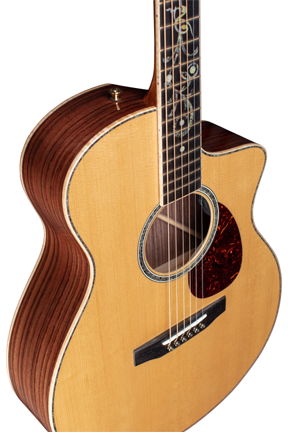 |
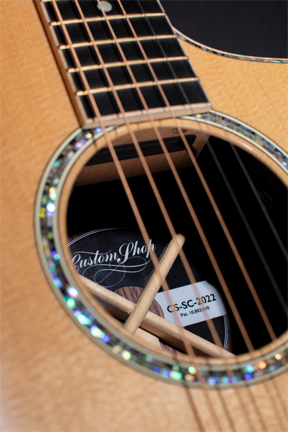 |
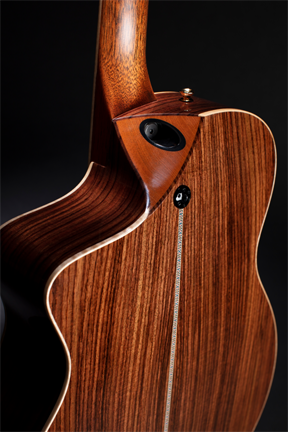 |
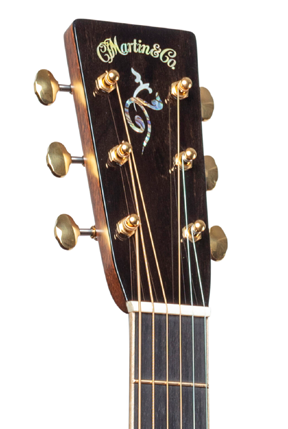 |
Ergonomic Engineering
The SC’s Low Profile Velocity neck has several innovative facets to its design. Firstly, it is helical.
There is a unique geometric twisting to the entire neck. Down by the nut, there is more mass behind the treble strings than the bass strings. This allows easier thumb-fretting while providing extra support where the fingers meet the hand. As the hand moves up the neck, the roll-off of the bass and treble sides even out to become more symmetrical.
But when the hand moves farther up toward the cutaway, the shaping flips, so there is more mass behind the bass strings, to support the thumb as it anchors the hand to the neck, and less mass behind the treble strings, for easier melody playing, chord voicings, and serious string bending during solos. This helical profile is downright ingenious.
The most amazing thing about the neck is how the shaping is so subtle it is not even noticed. It just feels relaxing and effortless to play. One quickly forgets about the neck altogether, while enjoying the heck out of fingerboard.
13-Fret Thinking
Then there is the patented Sure Align neck joint, which is achieved without a heel where the neck attaches to the body. The shaping where the neck attaches to the body has a comfortable scooped area that allows the fretting hand to remain parallel to the frets all the way up inside the generous cutaway. It is another brilliant idea that more than makes up for the neck joining the body at the 13th fret.
Martin wanted this ultra-modern SC design to split the difference between their original 12-fret guitars that reach back all the way to the 1830s and modern 14-fret guitars, which were invented at Martin in the 1930s. While playing a 13-fret neck for the first time can be a bit disorientating up near the cutaway, it takes maybe one song’s worth of playing to be happily converted to the SC way of making music.
The 13-fret neck configuration has the full 25.5” long scale (the playable length of the bass E string from the saddle to the nut,) but it feels as comfortable as a short-scale neck because all playing positions are closer to the body and to the player’s body. Having the long scale creates enough tension in the strings to put out better volume and projection. It also places the frets farther apart than on a short-scale neck, so the fingers won’t get into traffic jams up in the cutaway area. That is something I contend with all the time, since I play short-scale cutaways.
Another bonus is found in how remarkably balanced the CS-SC-22 is when suspended from a guitar strap. The weight is centered on the 13th fret, so a guitarist may let go with both hands and the instrument will remain in place, rather than having the body drop like a stone as the neck rockets skyward.
High Performance
The fingerboard has the High Performance Taper, used on most Martins today. The nut is a generous 1-3/4” wide, out where the wrist is bent at the most extreme angles. But the width at the 12th fret is only 2-1/8”, so there isn’t too wide a reach-around when playing complicated solos up the neck.
The combination of the Velocity profile and High Performance taper make for a svelte neck that is delightful to play. It’s fatigue-reducing ergonomics will be gratefully welcome in extend playing sessions and marathon jams.
Advanced Adjustability
Inside the Sure Align neck joint resides a “linear dovetail” connection that locks in place with an adjustable bolt that can be seen on the back of the cutaway, and another adjustment point inside the guitar, accessed by a specialized tool via the decorative grommet in the guitar’s back. On the CS-SC-22, the bolt has been aesthetically customized to match the grommet.
Some of the advanced SC engineering can be seen on the neck block inside the sound chamber. Next to the usual hole where the neck relief rod is adjusted, there is smaller hole with a setscrew. That is where precise adjustments are made to the intonation. When it comes to the main angle of the neck, there is a slot for prefabricated shims, which can be exchanged for thicker or thinner shims to perform a reset, without the expense and long wait times required to reset a traditional Martin neck.
Martin intends to soon publish how-to videos on setting SC relief and intonation. The company still recommends taking an SC model to a certified Martin repairperson for adjustments, but they know many musicians like to tinker with their guitars. They would rather educate owners by shedding light on the inner workings of the Linear Dovetail neck joint, than have them operating in the dark, as it were.
Liquidmetal Within and Without
Strong yet lightweight metal is used to create some parts of the patented heel-less neck joint developed via 3D printers (e.g. the dovetail and elevation plate.) But this CS-SC has those parts made from Liquidmetal.
Liquidmetal is the brand name for a type of metallic glass, more commonly known for its use as bridge pins, also included on the CS-SC-22. Its molecular structure allows energy to pass through the material without any loss to absorption.
In the case of bridge pins, no sound dampening occurs as the energy from the string passes through a pin on its way to the bridge plate. This results in increased volume and sustain of the fundamental notes. The same principal should apply to the neck joint, as vibrations passing along the neck are transferred through those Liquidmetal parts to the guitar’s body.
Ultra-Modern, Ultra-Deluxe
There is a lot more going on in the voice of this SC compared to the Road Series versions, and a lot more behind the scenes to make that happen. To be fair there is also a lot more money involved in acquiring this guitar.
Other limited editions with the CS prefix offered a variety of elite specs for a price well below what it would cost if someone were making a one-off Custom Shop order for the same instrument. Frankly, that concept holds true in this instance.
Where have we seen cutting edge specs in amalgamation with vintage Martin legacy features, like VTS Sitka tops with VTS Adirondack bracing attached with protein glue, along with liquid metal bridge pins, and EVO gold frets, on the same guitar with old timey Martin appointments like a 1931 headstock logo and open back tuning machines, and a 1930s style bridge shape?
For those who just said the Modern Deluxe Series, that’s correct, for 20 points.
While the CS-SC-22 may have the same body and neck shaping of the Road Series SCs, its construction and abalone styling is on par with the new 000-42 Modern Deluxe, and in some ways exceeds it. It lists for $800 more than that 000, but the CS-SC-22 is also the first solid-wood SC, built entirely in the Custom Shop, with other enhancements never released to the general public until now. It is hard to put a value on such exclusivity and cutting-edge technology. Something tells me that Martin will have little problem selling the expected 300 guitars.
When will we see another solid-wood SC made in the USA with the more down-to-earth appointments of the Standard Series? Unfortunately, the Martin factory just isn’t tooled-up to produce SCs on a regular basis. Only time will tell if that ever happens.
Conclusions
From the body size and the public spec sheet, one might assume this guitar will play and sound like the OM-42 or 000-28. That it does not. Even with the traditional woods it isn’t a typical Martin. It is an exceptional Martin. But it sounds much more like a traditional Martin than I ever expected.
Frankly, all modern Martins are set up too low for my beastly attack, and with too little relief. I would love to see what one of these SC models is like with old-timey Martin factory action, if not medium gauge strings in the bargain. Only then could I assess how differently this CS design sounds and behaves from one of my Custom Shop Martins.
Of course that setup would not allow for the hardcore electric guitar solos of the typical SC experience. The Road Series SC-13E sounds terrific when plugged-in, and I would consider one if I were still performing in venues on a frequent schedule. This Custom Shop SC, however, has taken things to much greater heights as a musical instrument, acoustic or electric.
The limited edition CS-SC-22 has the best electric tone and best acoustic tone yet available from this revolutionary 13-fret S size. For those who are seeking a high-end acoustic guitar that plays like an electric guitar, with a pickup system they can crank up to 11, it is a no-brainer.
It’s new-fangled ‘lectricguitarness aside, the bonuses in the 13-fret design, ergonomic Velocity neck profile, and best of the best Aura electronics remain mightily attractive. I absolutely would love to own one of these guitars for stage work, especially in a full band situation. I just cannot justify the purchase, short of some unforeseen windfall. But some 300 guitarists will, and I envy their future enjoyment.
That is one man’s word on the…
Martin CS-SC-22
List price: $7,999.00
More Photos HERE
Full CS-SC-22 Spec Sheet Here
